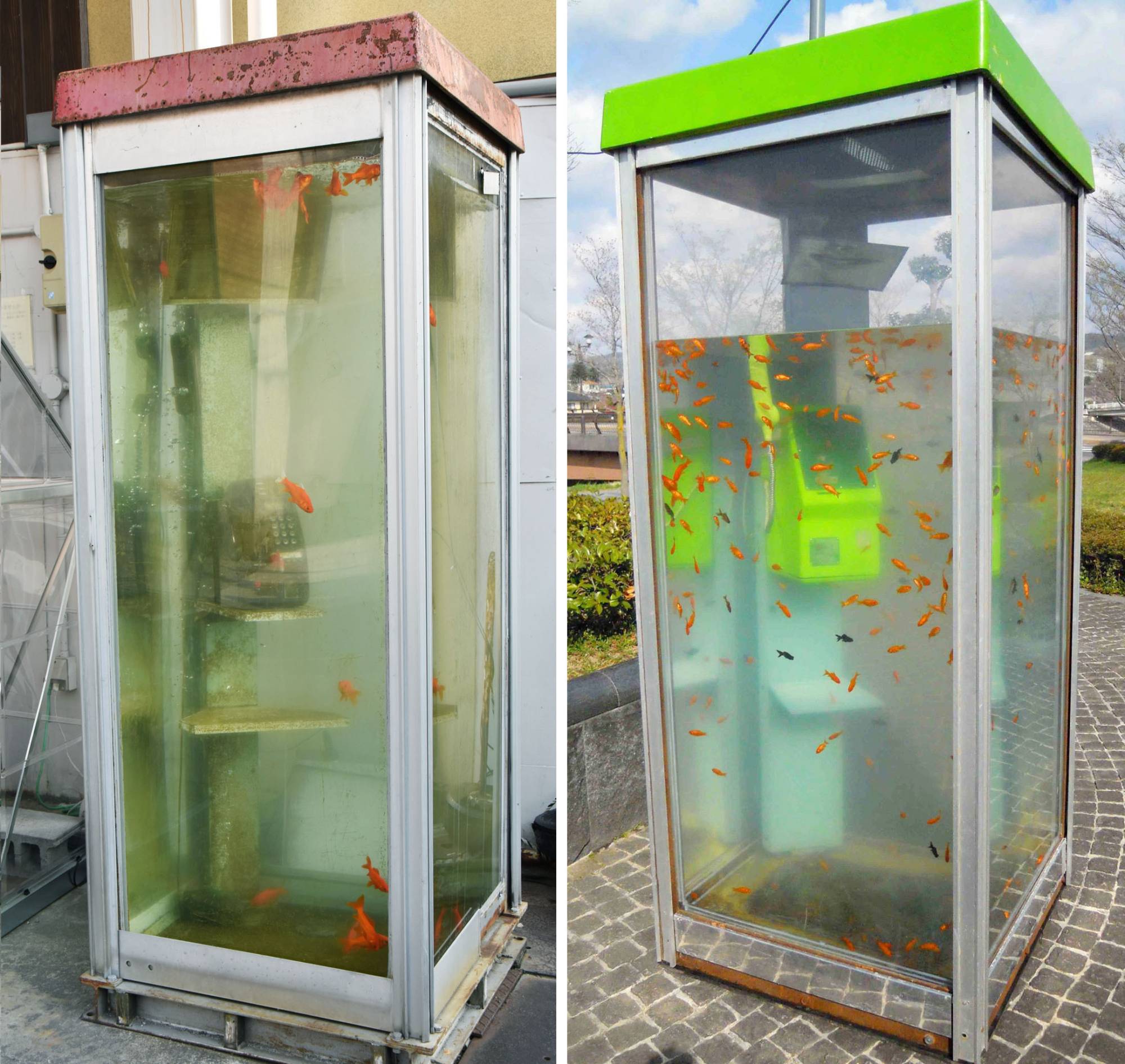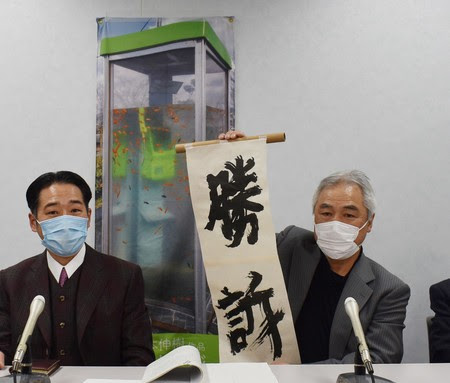The 'goldfish phone booth' copyright case in Japan

Nobuki Yamamoto, a Japanese contemporary artist, made an eye-catching work of ‘goldfish swimming in a phone booth’ (‘Work 1’) by December 2000 at the latest. In October 2011, a student organisation called ‘Goldfish Club’ at Kyoto University of Art and Design produced Work 2 and exhibited it for a week in the same month in the Osaka Nakanoshima Park.
In October 2013, Work 2 was transferred to a local organisation at Yamatokoriyama and exhibited there with the name of ‘goldfish telephone’. Then, it was transferred to Yamatokoriyama regional revitalisation (‘organisation Y’).
In February 2014, the organisation Y installed Work 2 in a shopping street at Yamatokoriyama and exhibited it for around four years. That was, of course, without the consent of Nobuki Yamamoto. In that period, the management body of Work 2 became a corporative association (‘the corporative Y’) whose members were individuals and small/medium-sized enterprises within Yamatokoriyama.
The Yamatokoriyama City at Nara Prefecture, by the way, is the ‘town of goldfish’ in Japan, where visitors can see kawaii goldfish elements everywhere as they stroll around.
In 2018, Nobuki Yamamoto filed a copyright infringement suit with Nara District Court, demanding the two defendants, i.e., the organisation Y and corporative Y, to pay jointly and severally 3,300,000 yen as damages.
First instance
[Full text of the ruling is accessible here, in Japanese.]
Issue 1: Copyrightability
The plaintiff claimed Work 1 original.
The defendants rebutted, ‘putting a goldfish into a public telephone box’ was merely an overly easy idea: ‘In other countries as well, there are several works in which goldfish swimming in public telephone boxes’; and the related expressions are limited by the appearance of telephone booth and goldfish: ‘It would be the same no matter who expresses it.’
Concerning the ‘bubble-making handset’, the defendants challenged its creativity, for ‘the structure of handset makes it necessary to inject air into the water. That inevitably arose when the plaintiff chose to put goldfish in the public telephone booth.’
The Court of First Instance (‘CFI’) opined that, (1) The plaintiff’s idea was indeed novel and original; it consisted of ‘weaving an extraordinary scene inside an everyday object’. A mere idea though is not subject to protection under the Copyright Act of Japan.
(2) About the ‘bubble from handset’ design, the CFI upheld the defendants’ claims:
If air bubbles are to be generated from an object usually existing in a public telephone booth, it is a reasonable and natural idea to generate them from a telephone receiver with a hole in it.
In other words, once the idea is decided, the choice of methods to realise it is limited, and therefore, creativity cannot be recognised in this respect.
Thus, no copyrightability could be recognised from the above features (1) and (2).
(3) On the other hand, some specific expressions in Work 1, e.g., the colour and shape of the public telephone booth-like product, colour, and arrangement of the public telephone installed inside, expressed the plaintiff’s thoughts and feelings.
Issue 2: Copyright infringement?
The plaintiff deemed the two works so highly similar that it was unimaginable to deem that Work 2 was created without depending on Work 1.
On the subjective side, the plaintiff mentioned that he had started to make repeated protests since October 2011, the first exhibition of Work 2. Moreover, meanwhile, his own Work 1 had been exhibited on numerous occasions and being reported by various media –Work 1 was ‘accessible not only to the general public but also to the producer of Work 2’.
The defendants argued:
(1) Putting goldfish into an ‘aquarium’ designed ‘for other purposes than ordinary aquariums for appreciation’ was an expression that could be easily produced by anyone;
(2) The plaintiff’s work was exhibited merely in a minimal manner: in a handful of cities: Tokyo, Kanagawa, Saitama, and Fukushima Prefectures; the time was a long time ago, between 1998 to 2001; its media coverage was merely regional. All in all, it would be untenable to assert that the defendants had the opportunity to access Work 1.
The CFI reviewed the disputes in three parts:
A. The differences between the two public telephone box-like external structure
(1) The roofs’ colour: one yellowish-green and the other red;
(2) Parts made by combining aluminium sashes and iron frames were used in Work 1, whereas Work 2 used the parts of an actual public telephone box.
B. The telephones installed inside
The two telephones differed in colour and models. Besides, as to the shelves, one was in light blue with squared shape, while the other was in silver and the shape of its lower shelf was triangular.
C. The telephone handsets
The CFI deemed the two telephone handsets were identical in the elements of ‘floating’ and ‘bubble-generation’.
The CFI held that, re A, ‘one telephone is placed on the upper shelf of the two shelves structure’ is common in public telephone booths in Japan. Typically, the lower shelf would be for keeping a telephone book. Thus, point A did not necessarily arise from the plaintiff’s idea. As a result, no creativity could be recognised in that respect.
The CFI acknowledged C’s specific expressions were indeed in common. Yet, that was ‘the sole similarity’ shared by the two works, by which, it was insufficient to admit the copyright infringement.
Thus, at that point, the CFI had decided not to review the plaintiff’s other claims (i.e., injunction and the existence and amount of damage), for the result would not be sufficient to affect the above finding.
Given the preceding, in July 2020, the plaintiff’s claims were dismissed by the CFI, without prejudice to the remaining issues.
Second instance
At the beginning of 2021, it was reported by the Japan Times that the Osaka High Court had overturned the CFI ruling and ordered the damages of JPY550,000 (EUR5,200) being paid to Nobuki Yamamoto for copyright infringement.
The judgement of the Osaka High Court is not published yet. According to Jiji Press, Nobuki Yamamoto said in the press conference following the court’s decision that ‘The court has upheld my claims in entirety.’

It is not sure yet whether the defendants will appeal. Work 2 had been removed from the said shopping street in 2018.
Comment
The CFI decision did not come as unexpected. It provided another reminder of the idea-expression dichotomy and the related merger doctrine.
Meanwhile, in this Kat’s view, the CFI seemed to have taken a relatively cautious approach in assessing the room for creativity upon the ‘bubble-generating handset’.
There seems to be a wide range of options available to choose from: at least, similar air holes could be easily made on the surface of the stand column on which the phone and shelves are fixed; Or, air holes can be on the bottom of the booth; let alone the various choices of disengaged objects, e.g., air stones. The ‘choice of methods to realise it’ seems not as narrowly limited as the CFI perceived.
Maybe the CFI saw the bubbling-handset serving multiple features simultaneously, i.e., ‘air-generating’ pluses ‘floating in the water’ pluses ‘conveying a meaning expression’ so on. In the absence of those multiple limiting conditions, this Kat finds it not easy to narrow down the possible choice of expression into a limited number of ways where the merger doctrine applies.
Besides, it remains unclear why the ‘Goldfish Club’ that made Work 2 in the first place was not listed as one of the defendants. Perhaps the publication of the second instance judgment will provide more details – stay tuned!
|
This blog was originally published on The IPKat - More blogs on Law Blogs Maastricht |